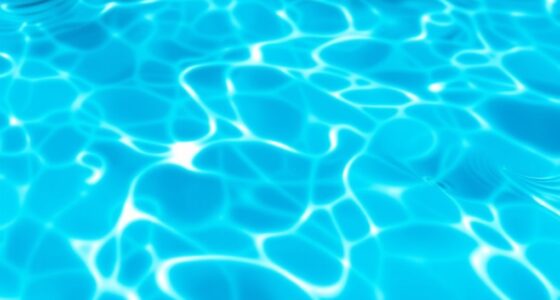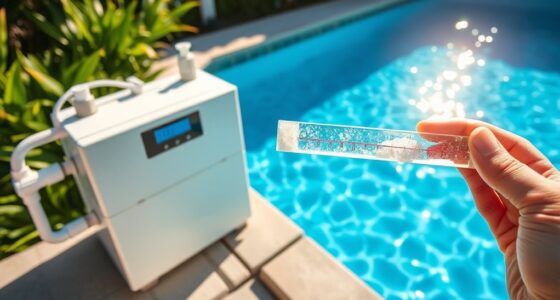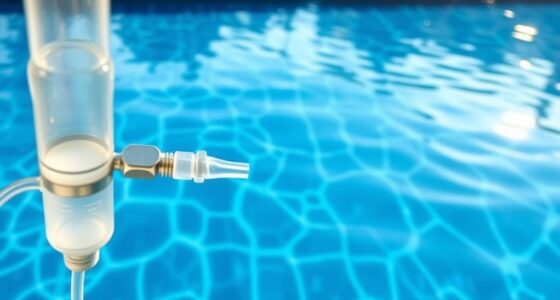Maintaining proper pool chemistry for salt systems in cold climates involves regular testing and adjustments of pH, alkalinity, calcium hardness, and salt levels to prevent scale, corrosion, and chemical imbalances. Keep an eye on sanitizer levels and use sequestrants to prevent mineral deposits. Insulating equipment and monitoring temperatures help protect your system during freezing. To keep your pool in top shape throughout winter, staying proactive with chemical management and maintenance is essential. If you continue, you’ll discover key strategies to keep your pool safe and efficient year-round.
Key Takeaways
- Regularly test salt, chlorine, pH, alkalinity, and calcium hardness to maintain proper chemical balance during cold weather.
- Keep salt levels within manufacturer-recommended ranges to prevent scaling and ensure salt system efficiency.
- Use sequestrants and calcium hardness inhibitors to prevent mineral buildup and scale formation in low temperatures.
- Maintain stable pH and alkalinity levels to protect equipment from corrosion and ensure sanitizer effectiveness.
- Insulate and protect equipment from freezing temperatures, and perform drain/refill procedures as needed to prevent damage.
Understanding Cold Climate Water Chemistry Challenges
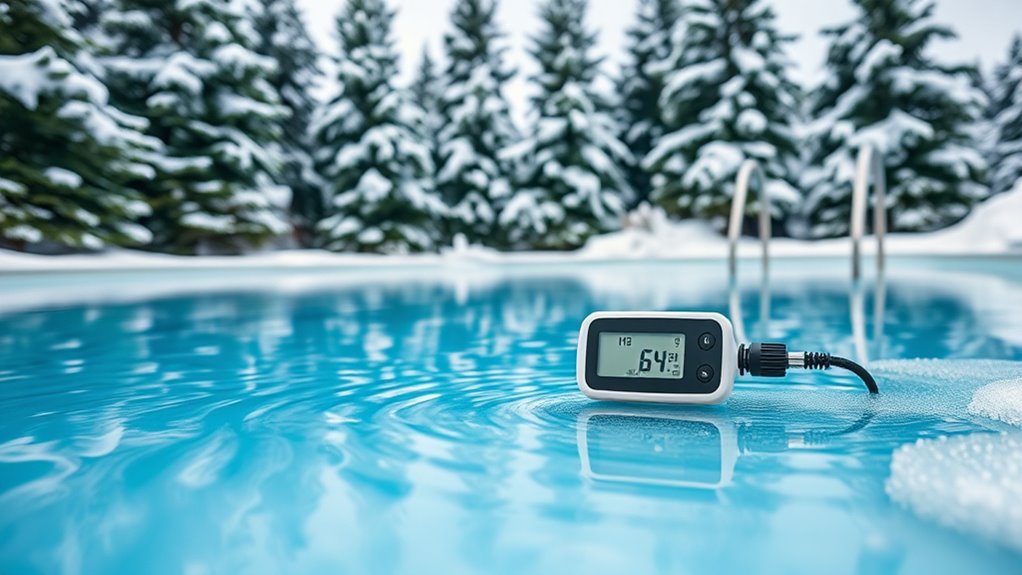
Cold climates pose unique water chemistry challenges for saltwater pool systems, especially during winter months. As temperatures drop, your pool’s chemical balance becomes harder to maintain. Cold water slows down chemical reactions, making sanitizer production less effective and increasing the risk of algae growth and bacteria buildup. Additionally, the solubility of salts and minerals changes with temperature, which can lead to imbalances in your water’s salinity and pH levels. You might notice fluctuations that require more frequent testing and adjustments. Regular monitoring of water chemistry helps you detect issues early and prevent costly damage. Changes in water temperature can also affect the efficiency of your salt cell and other equipment, requiring adjustments to keep everything functioning properly. Freezing temperatures can also cause physical damage to equipment and pool surfaces if proper precautions aren’t taken. Understanding these shifts helps you better anticipate issues and adopt strategies to keep your pool safe, clear, and properly balanced throughout the winter season. Proper water chemistry management and monitoring of chemical levels can mitigate many cold-weather issues and ensure your pool remains healthy. Additionally, being aware of salt solubility changes can help prevent unexpected salt precipitation and maintain proper salinity levels.
Maintaining Proper Ph Levels in Low Temperatures
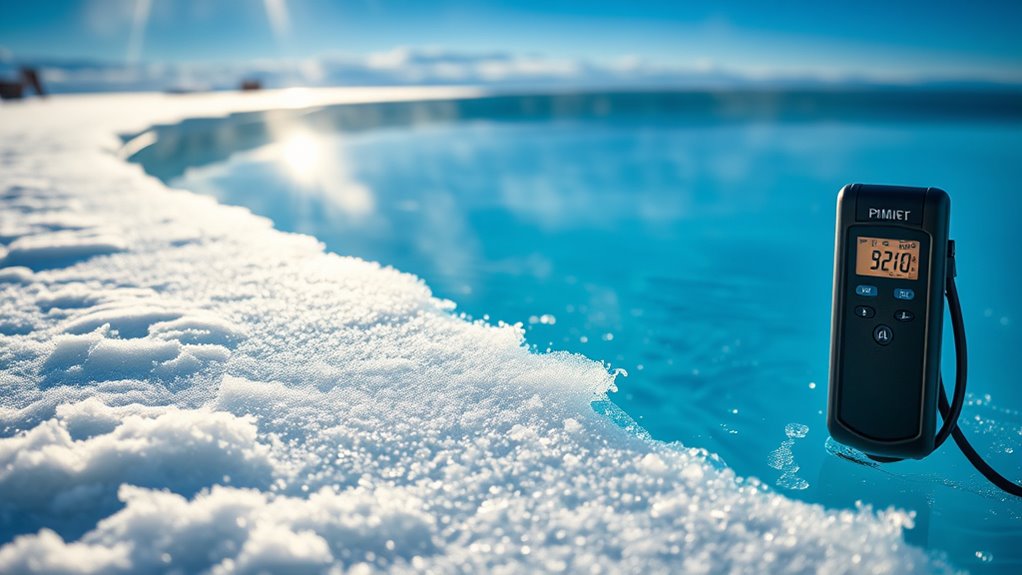
As temperatures drop, your pool’s pH levels can shift more quickly, affecting water balance and comfort. You need to monitor and adjust the pH carefully to prevent corrosion or scaling. Understanding how cold impacts pH and making timely adjustments keeps your salt system running smoothly. Regular testing of pH levels is essential, especially since water balance can be more unpredictable in low temperatures.
Cold Temperature Effects
Maintaining proper pH levels in saltwater pools becomes more challenging when temperatures drop, as low temperatures can affect the chemical balance and stability of your water. Cold weather slows down the chemical reactions that normally help maintain pH, causing potential fluctuations. This can lead to increased pH drift or instability, making it harder to keep water balanced. Additionally, lower temperatures reduce the efficiency of chlorine generation from salt systems, which can indirectly influence pH levels. You might notice that pH tends to rise or fall unexpectedly, requiring closer monitoring. To combat these effects, test your water more frequently during cold months and avoid making large chemical adjustments without precise testing. Staying vigilant helps ensure your pool remains balanced despite the temperature challenges. Regular use of proper filtration can also help maintain consistent water quality and chemical stability during colder periods. Understanding how temperature impacts chemical reactions can further assist in managing your pool chemistry effectively in winter conditions.
Adjusting Ph Levels
Adjusting pH levels in low temperatures requires careful attention because water chemistry behaves differently when it’s cold. Cold water can cause pH readings to shift unexpectedly, making it harder to maintain proper balance. You need to monitor pH more frequently and adjust promptly to prevent damage to your salt system and equipment. Use a reliable test kit designed for cold water, and always measure pH before adding chemicals. Keep in mind that low temperatures can slow chemical reactions, so adjustments may take longer to stabilize. To better understand your pool’s needs, consider these points:
- Cold water can mask true pH levels, leading to miscalculations
- Consistent testing helps prevent pH swings that harm salt cells
- Proper chemical dosing ensures stability despite temperature fluctuations
- Regularly replacing filters and maintaining equipment is essential for optimal performance HEPA Filtration.
- Additionally, understanding how water chemistry behaves in cold climates can improve your maintenance routine, especially since temperature effects on chemical reactions influence how your pool responds to adjustments. Incorporating knowledge of data-driven strategies can help you interpret test results more accurately and adjust your approach accordingly, especially when dealing with the unique challenges of low-temperature water chemistry.
Managing Calcium Hardness and Alkalinity During Winter

During winter, managing calcium hardness and alkalinity is essential to prevent scaling and water imbalance. You should focus on calcium scaling prevention, use alkalinity stabilization strategies, and perform regular water testing. These steps will help keep your salt system running smoothly in cold temperatures. Incorporating water chemistry management practices can further optimize system performance and longevity during the colder months. Additionally, maintaining proper water balance ensures that your salt system remains effective and reduces the risk of corrosion or damage. Regularly monitoring water chemistry levels helps detect any imbalances early, preventing potential issues before they escalate. Implementing drain and refill procedures during severe cold spells can also help mitigate freeze-related problems. Embracing a mindful approach to creative practice can also inspire innovative solutions for winter water maintenance challenges.
Calcium Scaling Prevention
As winter approaches, managing calcium hardness and alkalinity becomes vital to prevent calcium scaling in saltwater pools. High calcium levels can lead to deposits on the pool surface and equipment, especially in cold weather where water chemistry shifts. To prevent scaling, regularly test your water and keep calcium hardness within recommended ranges. Lowering calcium levels if they’re too high is essential before cold temperatures set in. Maintaining proper water circulation helps distribute minerals evenly, reducing risk areas. Additionally, using a calcium scale inhibitor can provide extra protection against deposits. Proper frost protection measures can also help prevent scale formation during freezing temperatures. Ensuring optimal water chemistry balance is crucial for preventing mineral buildup and maintaining pool integrity during winter months. Monitoring water mineral levels closely allows for timely adjustments and supports overall pool health during the colder season. Incorporating preventative maintenance routines can further safeguard your pool from damage caused by mineral buildup, especially when combined with seasonal water testing practices.
Alkalinity Stabilization Strategies
Maintaining stable alkalinity levels is essential for preventing calcium scale formation in saltwater pools during winter. To stabilize alkalinity, regularly test your levels and adjust with sodium bicarbonate as needed. Avoid large swings by making gradual adjustments, especially as temperatures drop. Keep alkalinity between 80-120 ppm to buffer pH changes effectively. If alkalinity is too high, dilute the water with fresh, warm water or use a lowering agent sparingly. Conversely, if it’s too low, add bicarbonate carefully. Managing calcium hardness is equally important; maintain levels around 200-400 ppm to prevent scale buildup. Using sequestrants can help prevent calcium precipitation. Consistent monitoring and incremental adjustments are key to maintaining proper alkalinity and calcium hardness during winter, ensuring your salt system operates smoothly and your pool stays clear. Additionally, understanding water chemistry principles can help you better anticipate and respond to seasonal changes.
Winter Water Testing
To guarantee your saltwater pool stays balanced throughout the winter, you need to regularly test both calcium hardness and alkalinity. Cold temperatures can cause chemical imbalances that lead to scaling or corrosion. Testing ensures you catch issues early and adjust levels accordingly. During winter, calcium hardness should stay within the recommended range to prevent scale formation or etching of the pool surface. Alkalinity controls pH stability, which is vital in cold weather. Regular testing helps you avoid damaging your equipment or creating cloudy water. Keep in mind:
- Low alkalinity can cause pH swings, leading to scale or corrosion
- High calcium hardness increases risk of scale buildup on pipes and surfaces
- Consistent testing helps maintain proper balance despite temperature fluctuations
Ensuring Chlorine and Salt Balance in Freezing Conditions
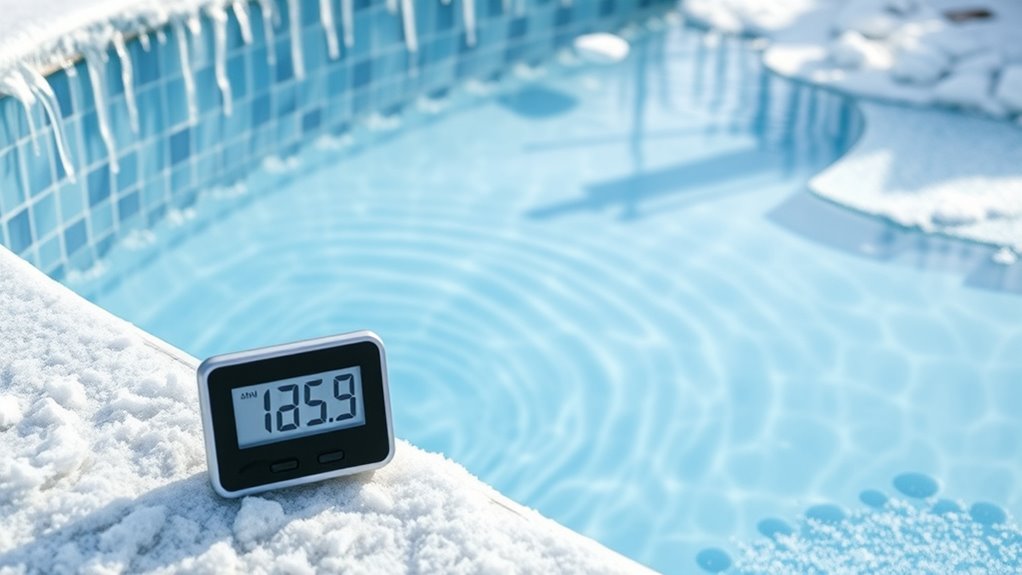
When temperatures drop below freezing, balancing chlorine and salt levels becomes essential to keep your saltwater pool safe and effective. Cold weather can cause chlorine levels to fluctuate, so test frequently and add sanitizer as needed to maintain the proper range. Low chlorine can lead to algae growth and bacteria buildup, while excess chlorine can damage pool components. Similarly, salt levels should stay within the manufacturer’s recommended range; too much salt can cause scaling, and too little reduces system efficiency. Use a reliable test kit to monitor both chlorine and salt regularly, especially during prolonged freezes. Adjust chlorine dosing carefully, and top off salt levels if they fall below the ideal range. Proper balance prevents issues and keeps your pool chemical stable during cold weather.
Preventing Corrosion of Salt System Components
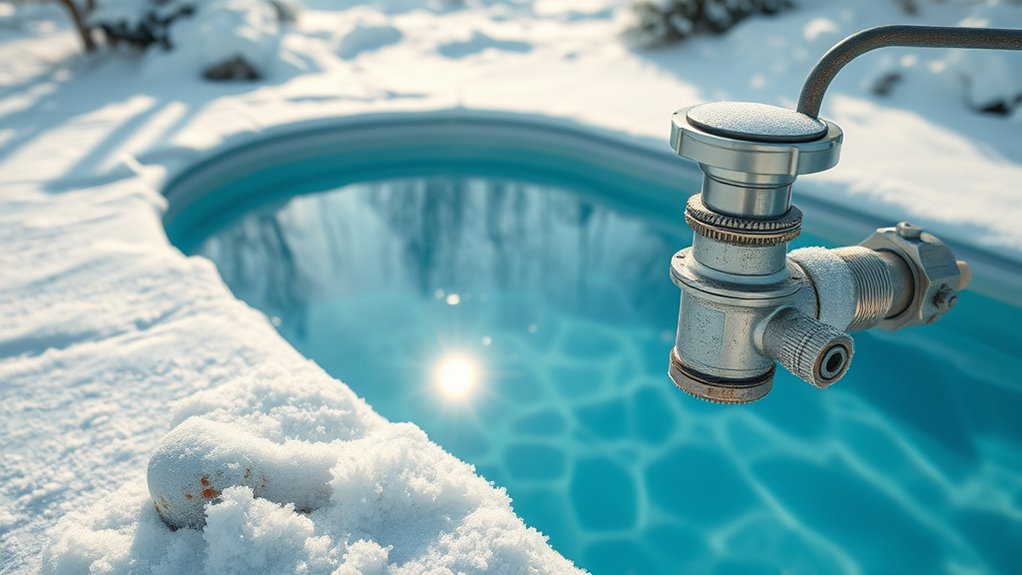
As you monitor and adjust chlorine and salt levels during cold weather, paying attention to corrosion risks becomes increasingly important. Salt system components, like electrodes and plumbing, are vulnerable to corrosion when pH, ORP, and salt levels aren’t properly maintained. To prevent damage, keep water chemistry balanced: avoid fluctuations that can accelerate corrosion. Regularly inspect equipment for signs of wear or corrosion, and promptly address issues before they worsen. Use corrosion-resistant materials where possible, such as plastic or coated metals. Additionally, maintaining proper circulation helps prevent stagnant areas where corrosion can develop.
- Ensure consistent pH and alkalinity levels to minimize corrosion potential
- Use corrosion inhibitors designed for salt systems
- Schedule routine inspections to catch early signs of deterioration
Monitoring and Adjusting Cyanuric Acid Levels
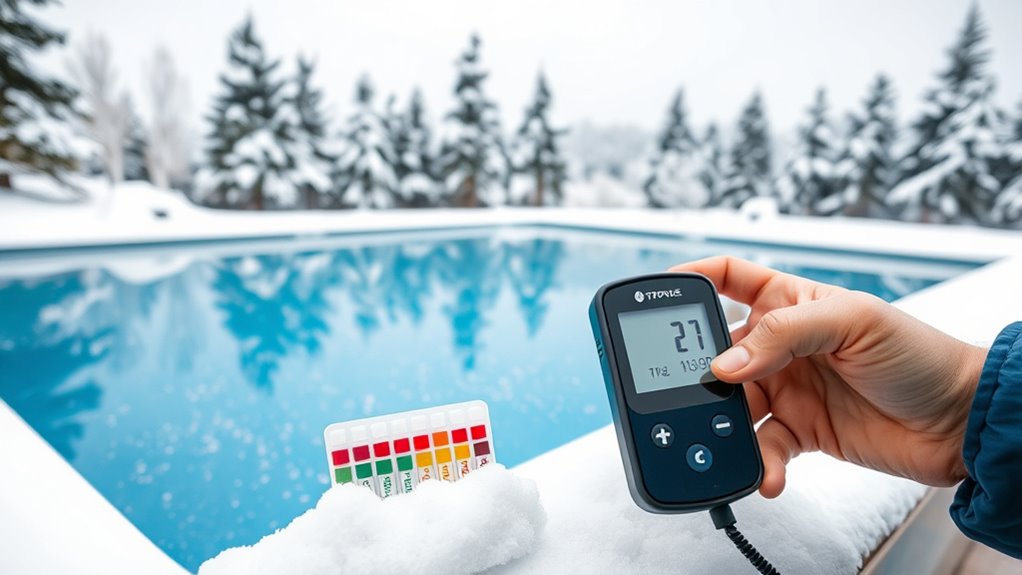
Monitoring and adjusting cyanuric acid levels is essential for maintaining effective chlorine stability in cold climates. Cyanuric acid helps protect chlorine from UV degradation, ensuring your sanitizer remains effective longer. In colder weather, chlorine can dissipate more slowly, but cyanuric acid levels still need to stay within the ideal range of 30-50 ppm. Use a reliable test kit to regularly check cyanuric acid levels, especially during seasonal changes. If levels are too high, dilute the water or partially drain and refill the pool. If they’re too low, add cyanuric acid carefully, following manufacturer instructions. Consistent monitoring helps prevent chlorine loss and maintains proper sanitation. Keep a log of test results to track trends and guarantee your pool remains balanced throughout the colder months.
Strategies for Winterizing Your Saltwater Pool
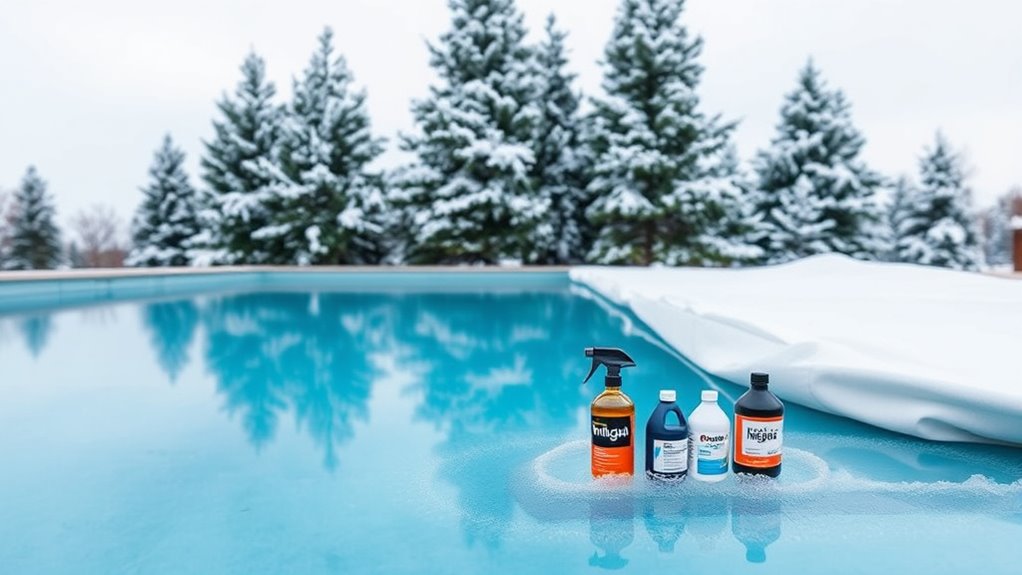
Properly winterizing your saltwater pool guarantees the water stays balanced and your equipment remains protected during cold months. To do this, you should lower the water temperature, balance the pH, alkalinity, and calcium hardness, and then add winterizing chemicals to prevent algae growth. It’s crucial to disconnect and clean equipment like the pump and filter, then drain and store them in a dry place. Using a pool cover helps keep debris out and maintains warmth.
Key strategies include:
- Ensuring proper chemical balance to prevent scale and corrosion
- Protecting equipment from freezing damage
- Using a quality cover to reduce debris buildup and evaporation
Tips for Safe and Effective Pool Opening in Spring
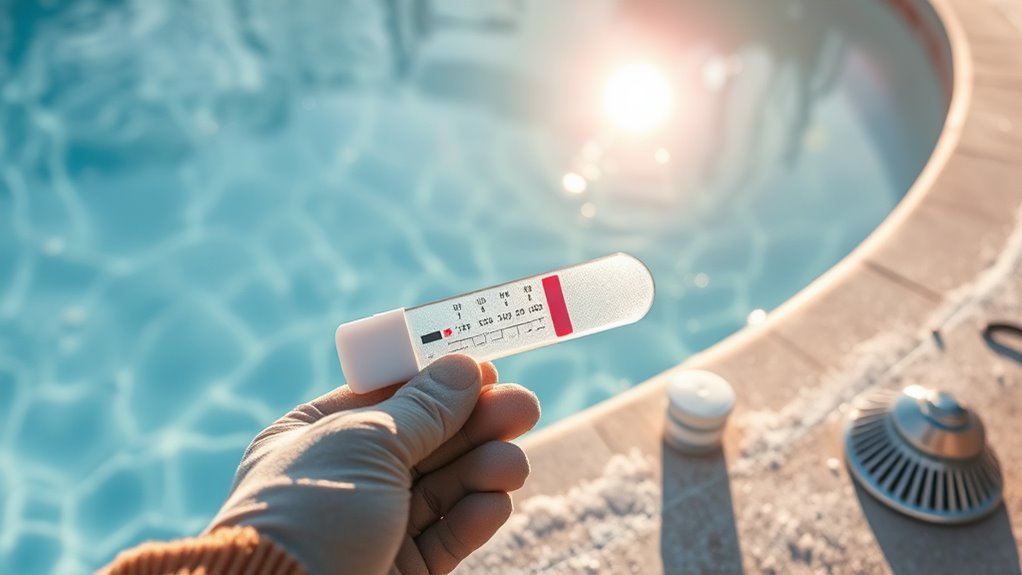
When spring arrives, a careful opening of your pool is crucial to facilitate a safe and smooth progression from winterization. Begin by removing covers and clearing debris to prevent contamination. Test your water’s chemistry, focusing on pH, alkalinity, and salt levels, adjusting them as needed to maintain proper balance. Check your salt system’s components, ensuring the salt cell is clean and functioning correctly. Run the pump and filter to circulate water and identify any issues early. Use a chlorine or sanitizer shock to eliminate bacteria and algae, especially if the pool has been unused. Regularly monitor water clarity and chemistry over the next few days, making adjustments as needed. Proper opening ensures your saltwater pool stays clean, safe, and ready for enjoyable swimming.
Frequently Asked Questions
How Does Cold Weather Impact Salt Cell Efficiency?
Cold weather can considerably impact your salt cell’s efficiency. When temperatures drop, the salt cell’s ability to generate chlorine decreases because the electrolysis process slows down. You might notice less sanitized water and longer filtration times. To keep your system running smoothly, you should reduce the salt cell’s running time, guarantee proper water circulation, and consider using a freeze protection method. Staying proactive helps maintain water quality and system performance during cold months.
What Are the Best Ways to Prevent Ice Damage to Pool Equipment?
Imagine your pool equipment as a delicate sculpture, vulnerable to winter’s icy grip. To prevent ice damage, you should drain water from pipes and equipment, insulate exposed components, and run the pump periodically to keep water moving. Cover the pool with a sturdy, insulated cover, and consider using a freeze protection system. These steps act like a warm blanket, shielding your equipment from the harsh cold.
How Often Should Salt Levels Be Checked in Winter?
You should check your salt levels at least once a month during winter to guarantee proper salt balance. Cold temperatures can cause fluctuations, so regular testing helps prevent issues like corrosion or poor chlorine production. Use a reliable test kit or meter, and adjust the salt levels as needed. Staying on top of this maintenance keeps your salt system functioning efficiently and protects your equipment from winter damage.
Can Salt Systems Operate Effectively Below Freezing Temperatures?
You might wonder if salt systems work below freezing. Typically, salt systems can operate effectively in cold temperatures, but their efficiency drops as water approaches freezing. You should guarantee your pool water stays above 32°F (0°C) to prevent freezing and potential damage. Regularly check salt levels and maintain proper chemical balance. Using a pool cover helps prevent ice formation, keeping your salt system running smoothly during winter.
What Are Common Signs of Corrosion in Salt System Components?
Corrosion signs in your salt system components include rust, discoloration, or pitting on metal parts. You might notice a decrease in system efficiency, leaks, or unusual noises. If you see corrosion or mineral buildup, it’s a red flag that your system isn’t properly balanced or protected. Regular inspections and maintenance help catch corrosion early, preventing costly repairs and keeping your pool system running smoothly.
Conclusion
Managing cold climate saltwater pools is like tending a delicate garden in winter—requires careful attention and the right balance. By monitoring your water chemistry, adjusting your treatments, and winterizing properly, you guarantee your pool stays healthy and ready for spring’s rebirth. With vigilance, your salt system can withstand the chill and flourish come warmer days. Stay proactive, and your pool will remain a sparkling oasis, resilient against the icy grip of winter.


